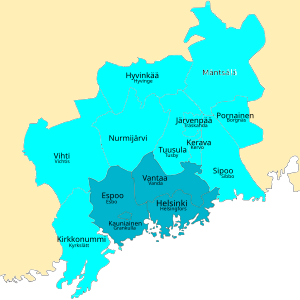Greater Helsinki
|
Greater Helsinki Helsingin seutu – Helsingforsregionen |
|
|---|---|
| Metropolitan area | |
 Greater Helsinki (light blue) and the Capital Region (dark blue) |
|
| Area | |
| • Land | 3,697.52 km2 (1,427.62 sq mi) |
| Population (2015) | |
| • Total | 1,441,601 |
| • Density | 389.9/km2 (1,010/sq mi) |
| Website | www.helsinkiregion.fi |
Greater Helsinki (Finnish: Helsingin seutu, Suur-Helsinki, Swedish: Helsingforsregionen, Storhelsingfors) is the metropolitan area including the smaller Capital Region (Pääkaupunkiseutu, Huvudstadsregionen) urban kernel and commuter towns surrounding Helsinki, the capital city of Finland. Greater Helsinki is sometimes incorrectly called (the) Helsinki Region due to an incorrect direct translation of the Finnish and Swedish terms Helsingin seutu and Helsingforsregionen.
These regions are located in the south of Finland, on the coast of the Gulf of Finland, which is part of the Baltic Sea. The smaller Capital Region includes Helsinki, Vantaa, Espoo, and Kauniainen and has a population of over 1.1 million. The Greater Helsinki region is the largest urbanised area in the country with 1,420,284 inhabitants and is by far the most important economic, cultural, and scientific region of Finland. Seven out of Finland's 17 universities and most of the headquarters of notable companies and governmental institutions are located in Greater Helsinki, as is Finland's main airline hub and airport, Helsinki Airport, which is located in Vantaa.
In the strictest sense, the Finnish Capital Region consists of four municipalities with city status, Helsinki, Vantaa, Espoo and Kauniainen, whose total population is about 1.1 million (2014). This area is most often called the Capital region in English, Pääkaupunkiseutu in Finnish, and Huvudstadsregionen in Swedish, although the use of the terms is not especially consistent. The vast majority of the inhabitants live in the urban areas of the cities, but within the boundaries of these cities there are also suburban and rural areas.
...
Wikipedia
